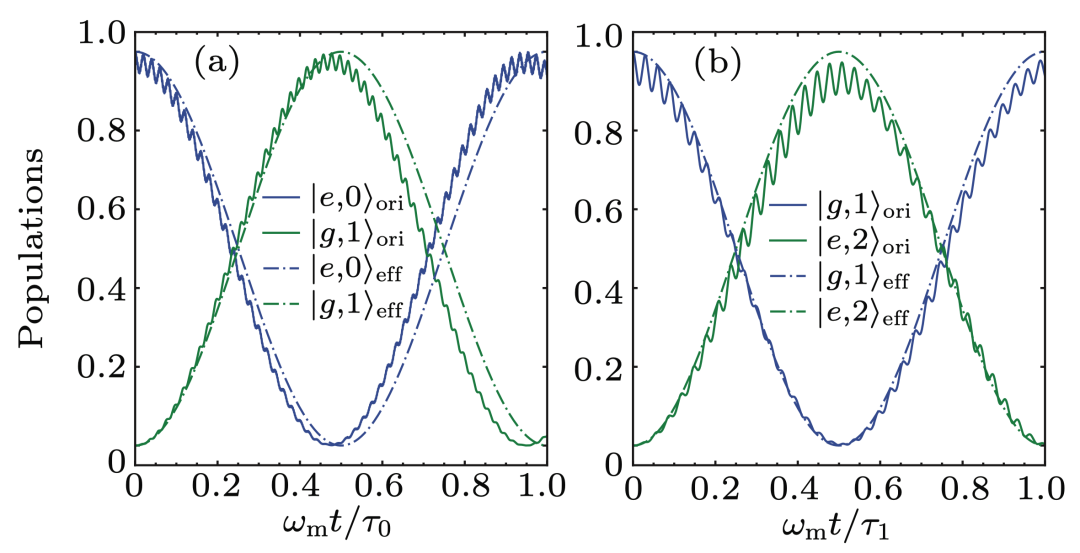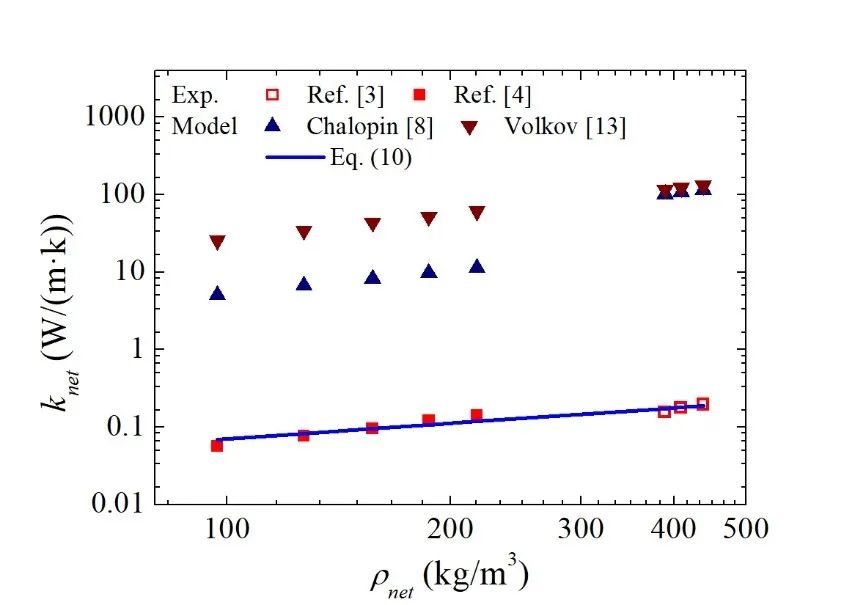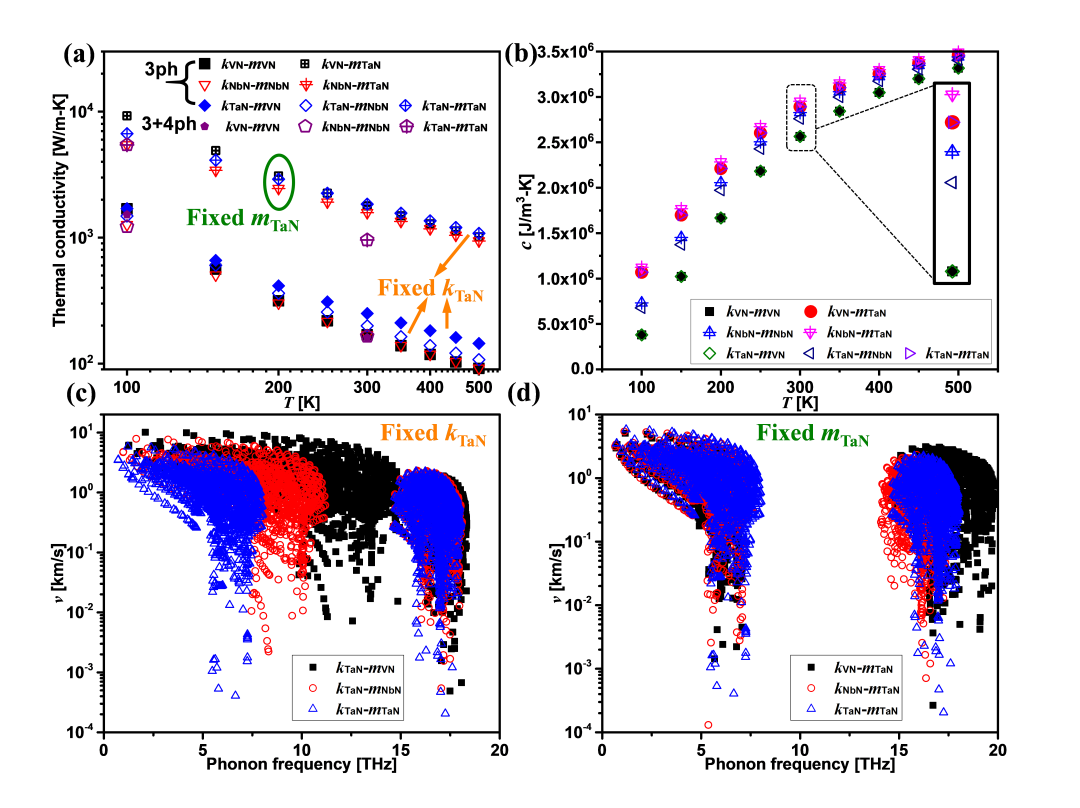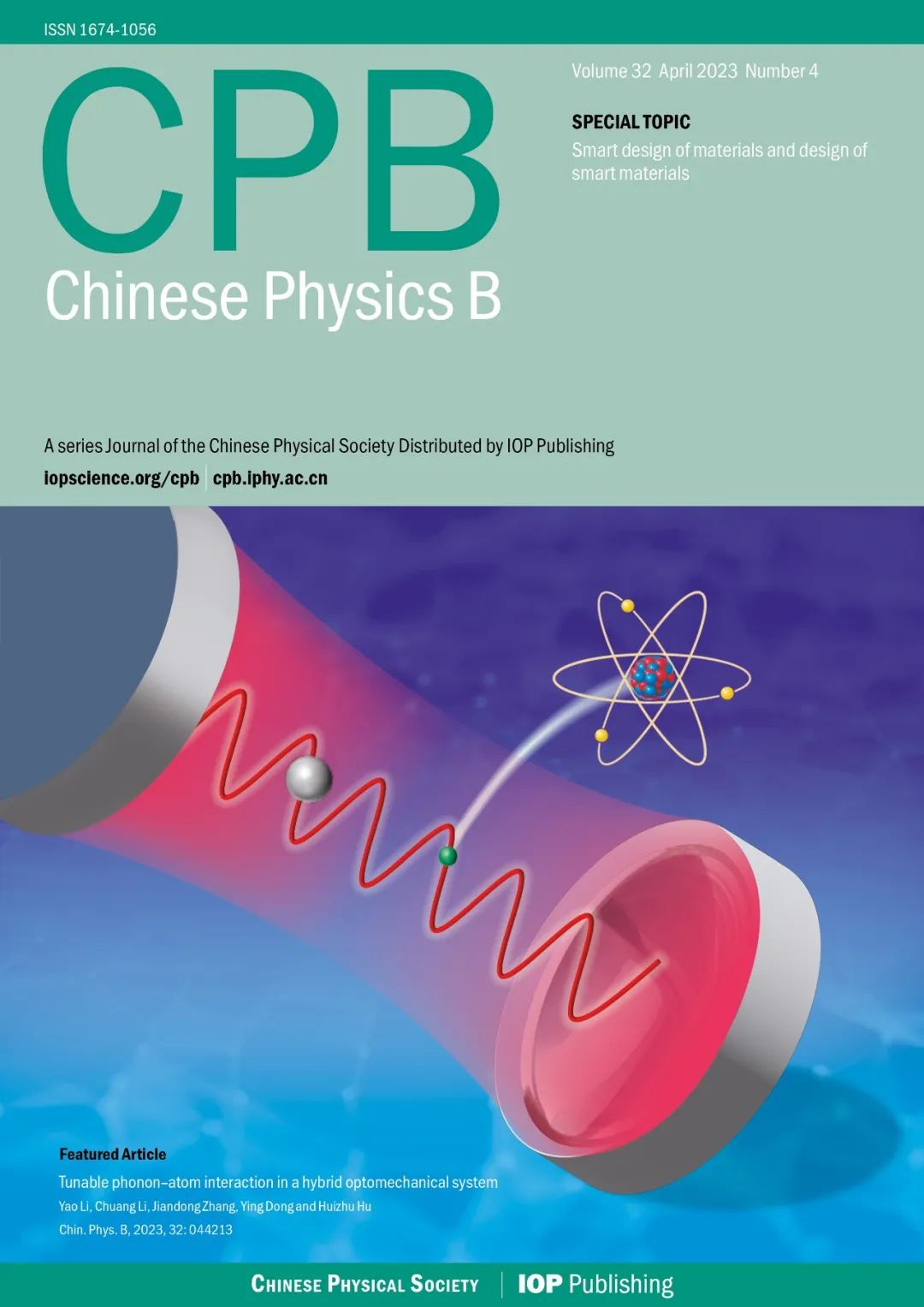博文
[转载]CPB封面文章和亮点文章 | 2023年第4期
||

Tunable phonon-atom interaction in a hybrid optomechanical system
Yao Li(李耀), Chuang Li(李闯), Jiandong Zhang(张建东), Ying Dong(董莹), and Huizhu Hu(胡慧珠)
Chin. Phys. B, 2023, 32 (4): 044213

近些年,悬浮光力系统成为物理学领域的研究热点之一。悬浮光力系统可以以超高的精度控制纳米微粒的多个运动自由度,使其不仅在精密测量领域展现出极大的应用前景,而且为前沿基础物理问题的研究提供了一个理想的实验平台。随着量子基态冷却的实现,悬浮光力系统的研究也正式步入量子领域。如何精确地操控悬浮微粒的量子态成为悬浮光力系统下一步发展所面临的问题之一。
为解决上述问题,本文作者理论上研究了一个新型的混合悬浮光力系统,其中,一个中性原子和一个纳米微粒同时悬浮在一个光学腔中。腔中驻波光场作为桥梁,同时与原子和微粒耦合,使它们间形成一个等效的相互作用。这个相互相作用依赖于腔光场且易于调控,通过简单地改变腔光场失谐,就能实现声子-原子相互作用在JC形式和anti-JC形式间的转换。基于这种可控的等效相互作用,通过调控原子就可以精确操控微粒质心运动的量子态,例如,将微粒质心运动制备在任意Fock态以及相应的量子叠加态上、操控微粒质心运动在不同Fock态间转换等。该工作有望应用在量子精密测量、量子信息、以及前沿基础问题研究等方面,促进悬浮光力学的发展和进步。
原文链接

Fig. 2. The populations of the states |e,0⟩, |g,1⟩, |g,2⟩ and as a function of time respectively determined by the original AOC Hamiltonian in Eq. (6) and the effective (a) JC and (b) anti-JC AO Hamiltonians in Eqs. (9) and (10). The parameters are set as follows: (a) ωb = 1, ∆′c = 1.1, ωs = 0, ∆e = −11.4688, ∆g = −12.5, ga = 0.2, Ω = 0.5981, Gm = 0.01 and (b) ωb = 1, ∆′c = −0.9, ωs = 0, ∆e = −10.2748, ∆g = −9.3, ga = 0.2, Ω = 0.4882, Gm = 0.01.

Modeling of thermal conductivity for disordered carbon nanotube networks
Hao Yin(殷浩), Zhiguo Liu(刘治国), and Juekuan Yang(杨决宽)
Chin. Phys. B, 2023, 32 (4): 044401

碳纳米管网络的导热系数比单根碳纳米管低3~4个数量级。为了解释为什么碳纳米管网络具有如此低的导热系数,研究者已提出了多个理论模型。但这些理论模型所给出的预测值都比碳纳米管网络的实验结果高出1个数量级以上。在这篇文章中,我们分析了已有模型中不合理的假设,在此基础上提出将碳纳米管网络看作是接触热阻网络。在接触热阻网络中,单根碳纳米管的温度是不均匀的,但碳纳米管的本征热阻可以忽略。基于该接触热阻网络模型,我们对单壁碳纳米管网络的导热系数进行了预测,预测结果同文献中的实验结果最大误差为21.0%,远小于已有理论模型的误差值。
本文所提出的导热模型还可以用于纳米纤维等网络。该模型给出了提升该类网络导热性能的两个可行的途径:提升纳米管或纤维之间的接触热导和提升网络密度。
原文链接

Fig. The calculated thermal conductivities of SWCNT networks versus the experimental values at 300 K. The blue line is given by our model. The squares are experimental results from Refs. 3 and 4. The triangles are predictions given by other models.

Effects of phonon bandgap on phonon-phonon scattering in ultrahigh thermal conductivity θ-phase TaN
Chao Wu(吴超) and Chenhan Liu(刘晨晗)
Chin. Phys. B, 2023, 32 (4): 046502

随着集成电路中晶体管尺寸的不断缩小,优化纳米级电子和光电设备的散热成为一项新兴挑战。因此,超高导热材料以其出色的导热能力,在热管理领域受到越来越多的关注。依据Lindsay等人2013年提出的准则,大声子带隙的材料往往具有高的导热系数。据此,θ相TaN最近被预测室温下拥有近1000 W/(mžK)的导热系数。尽管如此,但是θ相TaN中大的带隙如何通过影响三声子过程和四声子过程来影响导热系数还不太清楚。因此,本文基于第一性原理计算在XN(X = V, Nb, Ta)中系统深入地研究了带隙对三声子过程和四声子过程的影响机制。
计算结果显示X的质量改变对声子带隙有显著的影响,而X变化引起的力常数变化对带隙影响很弱。质量改变引起的带隙改变能够显著改变三声子过程,而对四声子过程影响甚微。θ相TaN超高的导热系数主要来自于大声子带隙引起的长声子寿命,包括三声子寿命和四声子寿命。本文的研究结果加深了对声子传输的声子带隙效应的理解,可为寻找超高导热系数材料提供指导。
原文链接

Fig. 3. Thermal properties of XN. (a) Temperature dependent thermal conductivity in XN. “3ph” and “3+4ph”, respectively, means the only three-phonon process and both the three-phonon and four-phonon processes for thermal conductivity calculation. “Fixed mTaN” means the case for “kVN-mTaN”, “kNbN-mTaN”, and “kTaN-mTaN” while “Fixed kTaN” means the case for “kTaN-mVN”, “kTaN-mNbN”, and “kTaN-mTaN”. (b) Temperature dependent specific heat in XN. Phonon frequency dependent phonon group velocity for “Fixed mTaN” (c) and “Fixed kTaN” (d).

Conductive path and local oxygen-vacancy dynamics: Case study of crosshatched oxides
Z W Liang(梁正伟), P Wu(吴平), L C Wang(王利晨), B G Shen(沈保根), and Zhi-Hong Wang(王志宏)
Chin. Phys. B, 2023, 32 (4): 047303

功能导向的缺陷调控是凝聚态物理和材料科学持久关注的课题之一。近年来,忆阻效应由于其在非易失存储和神经形态计算方面的应用前景而引起人们的广泛关注。然而,对于氧化物电致阻变,相关氧空位动力学机制目前仍未获得清晰认识。一方面,氧空位的局域电致迁移一般发生在金属/氧化物界面处或氧化物介质内部,难以被观测;另一方面,除氧空位外,氧化物薄膜生长过程中往往还会引入失配和穿透位错。氧空位与这些扩展缺陷之间的关联还有待阐释。
本研究基于锰氧化物薄膜表面特殊交叉线(crosshatch)的生长,通过导电原子力扫描显微镜(CAFM)实时探测局域电场下的导电路径和氧空位动力学响应。研究结果显示,CAFM模式下的电导交叉线与形貌交叉线并非一一对应;而局域阈型阻变或忆阻的产生则依赖于失配和穿透位错调制下氧空位浓度和组态的演变。本文工作为阻变氧空位动力学提供了新的理解和研究途径。
原文链接

Fig. 7. For FS-80, the simultaneous AFM (a) and CAFM imaging (b) at –5 V in the region including the site S2 just after finishing the I–V measurements. The positions for the emerged CDs at S2' and at about the imaging center M are marked out by dashed circles. The emerged CL along the half diagonal is denoted by MN. The arrows in (a) indicate the light TL adjacent to the feature of MN along the half diagonal. (c)–(f) The CAFM imaging at –5 V, consecutively scanned from (c) to (d), (e), and (f).

Strong spin frustration and magnetism in kagomé antiferromagnets LnCu3(OH)6Br3 (Ln=Nd, Sm, and Eu)
Jin-Qun Zhong(钟金群), Zhen-Wei Yu(余振伟), Xiao-Yu Yue(岳小宇), Yi-Yan Wang(王义炎), Hui Liang(梁慧), Yan Sun(孙燕), Dan-Dan Wu(吴丹丹), Zong-Ling Ding(丁宗玲), Jin Sun(孙进), Xue-Feng Sun(孙学峰), and Qiu-Ju Li(李秋菊)
Chin. Phys. B, 2023, 32 (4): 047505

近年来,含Cu2+ 离子的二维kagomé 反铁磁体备受关注,这类材料因具有低维和强阻挫效应成为研究量子磁性的理想载体。其中具有完美Cu2+-kagomé晶格的YCu3(OH)6Br2[Brx(OH)1-x] 被认为是量子自旋液体的候选材料。与此同时,关于LnCu3(OH)6Cl3 (Ln = Nd,Sm,Eu,Gd,Tb,Dy) 的研究发现,磁性Ln3+ 离子替代非磁性Y3+ 离子不仅改变了Cu2+ 离子间的反铁磁关联,还使得LnCu3(OH)6Cl3材料因Ln3+ 离子的不同而展现出丰富的基态磁性质。
本文研究了稀土Ln3+ 离子对阻挫反铁磁体LnCu3(OH)6Br3 基态磁性质的影响,采用水热法制备了高质量的LnCu3(OH)6Br3 (Ln = Nd, Sm, Eu) 单晶,并对其在低温下的磁化率及比热进行了细致的研究。磁性测量结果显示这些材料具有反铁磁交换作用和较强的自旋阻挫效应,在16 K附近Cu2+ 离子自旋形成了倾斜的反铁磁态。低温下Ln3+ 离子与Cu2+ 离子间的磁性竞争还诱导了低温负磁化行为,比热曲线上也观察到Ln3+ 离子引起的肖特基异常。本文实验结果表明Cu2+-kagomé 晶格的反铁磁体系中磁性稀土离子的引入可以产生更多奇特的低温磁性行为。
原文链接

Fig. 5. Zero field-cooling (ZFC) and field-cooling (FC) magnetic susceptibilities of LnCu3(OH)6Br3 (Ln = Nd, Sm, and Eu) single crystals under the c-axis magnetic field of 50 Oe, 5 Oe, and 50 Oe, respectively.

SPECIAL TOPIC — Smart design of materials and design of smart materials
SPECIAL TOPIC — Celebrating the 100th Anniversary of Physics Discipline of Xiamen University
TOPICAL REVIEW — Physics in micro-LED and quantum dots devices
TOPICAL REVIEW — Celebrating 30 Years of Chinese Physics B
TOPICAL REVIEW — The third carbon: Carbyne with one-dimensional sp-carbon
SPECIAL TOPIC — Fabrication and manipulation of the second-generation quantum systems
SPECIAL TOPIC — Celebrating the 70th Anniversary of the Physics of Jilin University
TOPICAL REVIEW—Laser and plasma assisted synthesis of advanced nanomaterials in liquids
TOPICAL REVIEW — Progress in thermoelectric materials and devices
SPECIAL TOPIC — Emerging photovoltaic materials and devices
SPECIAL TOPIC — Organic and hybrid thermoelectrics
SPECIAL TOPIC — Superconductivity in vanadium-based kagome materials
SPECIAL TOPIC— Interdisciplinary physics: Complex network dynamics and emerging technologies
SPECIAL TOPIC — Non-Hermitian physics
SPECIAL TOPIC — Unconventional superconductivity
SPECIAL TOPIC — Two-dimensional magnetic materials and devices
SPECIAL TOPIC — Ion beam modification of materials and applications
SPECIAL TOPIC — Quantum computation and quantum simulation
SPECIAL TOPIC —Twistronics
SPECIAL TOPIC — Machine learning in condensed matter physics
SPECIAL TOPIC — Phononics and phonon engineering
SPECIAL TOPIC — Water at molecular level
SPECIAL TOPIC — Optical field manipulation
SPECIAL TOPIC — Modeling and simulations for the structures and functions of proteins and nucleic acids
SPECIAL TOPIC —Terahertz physics
SPECIAL TOPIC — Ultracold atom and its application in precision measurement
SPECIAL TOPIC — Topological 2D materials
SPECIAL TOPIC — Active matters physics
SPECIAL TOPIC — Physics in neuromorphic devices
SPECIAL TOPIC — Advanced calculation & characterization of energy storage materials & devices at multiple scale
TOPICAL REVIEW — Advanced calculation & characterization of energy storage materials & devices at multiple scale
TOPICAL REVIEW — Quantum dot displays
TOPICAL REVIEW — CALYPSO structure prediction methodology and its applications to materials discovery
SPECIAL TOPIC — A celebration of the 100th birthday of Kun Huang
TOPICAL REVIEW — A celebration of the 100th birthday of Kun Huang
SPECIAL TOPIC — Strong-field atomic and molecular physics
TOPICAL REVIEW — Strong-field atomic and molecular physics
TOPICAL REVIEW — Topological semimetals
SPECIAL TOPIC — Topological semimetals
SPECIAL TOPIC — Photodetector: Materials, physics, and applications
TOPICAL REVIEW — Photodetector: Materials, physics, and applications
TOPICAL REVIEW — Fundamental research under high magnetic fields
Virtual Special Topic — High temperature superconductivity
Virtual Special Topic — Magnetism and Magnetic Materials

官网:http://cpb.iphy.ac.cn https://iopscience.iop.org/journal/1674-1056
https://m.sciencenet.cn/blog-3377544-1386857.html
上一篇:[转载]CPB2023年第3期编辑推荐文章
下一篇:[转载]CPB2023年第4期编辑推荐文章
